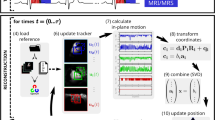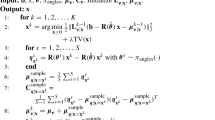Abstract
Motion artifacts can compromise the diagnostic value of computed tomography (CT) images. Motion correction approaches require a per-scan estimation of patient-specific motion patterns. In this work, we train a score-based model to act as a probability density estimator for clean head CT images. Given the trained model, we quantify the deviation of a given motion-affected CT image from the ideal distribution through likelihood computation. We demonstrate that the likelihood can be utilized as a surrogate metric for motion artifact severity in the CT image facilitating the application of an iterative, gradient-based motion compensation algorithm. By optimizing the underlying motion parameters to maximize likelihood, our method effectively reduces motion artifacts, bringing the image closer to the distribution of motion-free scans. Our approach achieves comparable performance to state-of-the-art methods while eliminating the need for a representative data set of motion-affected samples. This is particularly advantageous in real-world applications, where patient motion patterns may exhibit unforeseen variability, ensuring robustness without implicit assumptions about recoverable motion types.
Access this chapter
Tax calculation will be finalised at checkout
Purchases are for personal use only
Similar content being viewed by others
References
Aichert, A., et al.: Epipolar consistency in transmission imaging. IEEE Trans. Med. Imaging 34(11), 2205–2219 (2015)
Berger, M., et al.: Motion compensation for cone-beam CT using Fourier consistency conditions. Phys. Med. Biol. 62(17), 7181 (2017)
Caterini, A.L., Loaiza-Ganem, G.: Entropic issues in likelihood-based OOD detection. In: I (Still) Can’t Believe It’s Not Better! Workshop at NeurIPS 2021, pp. 21–26. PMLR (2022)
Chen, R.T., Rubanova, Y., Bettencourt, J., Duvenaud, D.K.: Neural ordinary differential equations. In: Advances in Neural Information Processing Systems, vol. 31 (2018)
Chilamkurthy, S., et al.: Deep learning algorithms for detection of critical findings in head CT scans: a retrospective study. The Lancet 392(10162), 2388–2396 (2018). http://headctstudy.qure.ai/dataset
Choi, J.H., et al.: Fiducial marker-based correction for involuntary motion in weight-bearing C-arm CT scanning of knees. Part I. numerical model-based optimization. Med. Phys. 40(9), 091905 (2013)
Choi, S., Lee, H., Lee, H., Lee, M.: Projection regret: reducing background bias for novelty detection via diffusion models. In: Advances in Neural Information Processing Systems, vol. 36 (2024)
Denouden, T., Salay, R., Czarnecki, K., Abdelzad, V., Phan, B., Vernekar, S.: Improving Reconstruction Autoencoder Out-of-distribution Detection with Mahalanobis Distance (2018). arXiv preprint arXiv:1812.02765
Goodier, J., Campbell, N.D.: Likelihood-based Out-of-Distribution Detection with Denoising Diffusion Probabilistic Models (2023). arXiv preprint arXiv:2310.17432
Graham, M.S., et al.: Unsupervised 3D out-of-distribution detection with latent diffusion models. In: Greenspan, H., et al. Medical Image Computing and Computer Assisted Intervention - MICCAI 2023. MICCAI 2023. LNCS, vol. 14220. Springer, Cham (2023). https://doi.org/10.1007/978-3-031-43907-0_43
Grathwohl, W., Chen, R.T., Bettencourt, J., Sutskever, I., Duvenaud, D.: FFJORD: free-form continuous dynamics for scalable reversible generative models. In: International Conference on Learning Representations (2018)
Huang, H., et al.: Reference-free learning-based similarity metric for motion compensation in cone-beam CT. Phys. Med. Biol. 67(12), 125020 (2022)
Hutchinson, M.F.: A stochastic estimator of the trace of the influence matrix for Laplacian smoothing splines. Commun. Stat. Simul. Comput. 18(3), 1059–1076 (1989)
Kingston, A., Sakellariou, A., Varslot, T., Myers, G., Sheppard, A.: Reliable automatic alignment of tomographic projection data by passive auto-focus. Med. Phys. 38(9), 4934–4945 (2011)
Köthe, U.: A review of change of variable formulas for generative modeling (2023). arXiv preprint arXiv:2308.02652
Levac, B., Kumar, S., Jalal, A., Tamir, J.I.: Accelerated motion correction with deep generative diffusion models. Magn. Reson. Med. 92(2), 853–868 (2024)
Linmans, J., Raya, G., van der Laak, J., Litjens, G.: Diffusion models for out-of-distribution detection in digital pathology. Med. Image Anal. 93, 103088 (2024)
Maier, J., et al.: Inertial measurements for motion compensation in weight-bearing cone-beam CT of the knee. In: Martel, A.L., et al. (eds.) MICCAI 2020. LNCS, vol. 12263, pp. 14–23. Springer, Cham (2020). https://doi.org/10.1007/978-3-030-59716-0_2
Müller, J.P., Baugh, M., Tan, J., Dombrowski, M., Kainz, B.: Confidence-aware and self-supervised image anomaly localisation. In: Sudre, C.H., Baumgartner, C.F., Dalca, A., Mehta, R., Qin, C., Wells, W.M. (eds.) Uncertainty for Safe Utilization of Machine Learning in Medical Imaging. UNSURE 2023. LNCS, vol. 14291. Springer, Cham (2023). https://doi.org/10.1007/978-3-031-44336-7_18
Nalisnick, E., Matsukawa, A., Teh, Y.W., Gorur, D., Lakshminarayanan, B.: Do deep generative models know what they don’t know? In: International Conference on Learning Representations (2019)
Preuhs, A., et al.: Appearance learning for image-based motion estimation in tomography. IEEE Trans. Med. Imaging 39(11), 3667–3678 (2020)
Ren, J., et al.: Likelihood ratios for out-of-distribution detection. In: Advances in Neural Information Processing Systems, vol. 32 (2019)
Sisniega, A., Stayman, J.W., Yorkston, J., Siewerdsen, J., Zbijewski, W.: Motion compensation in extremity cone-beam CT using a penalized image sharpness criterion. Phys. Med. Biol. 62(9), 3712 (2017)
Song, Y., Sohl-Dickstein, J., Kingma, D.P., Kumar, A., Ermon, S., Poole, B.: Score-based generative modeling through stochastic differential equations. In: International Conference on Learning Representations (2021)
Thies, M., et al.: Gradient-based geometry learning for fan-beam CT reconstruction. Phys. Med. Biol. 68(20), 205004 (2023)
Thies, M., et al.: A gradient-based approach to fast and accurate head motion compensation in cone-beam CT (2024). arXiv preprint arXiv:2401.09283
Wolleb, J., Bieder, F., Sandkühler, R., Cattin, P.C.: Diffusion models for medical anomaly detection. In: Wang, L., Dou, Q., Fletcher, P.T., Speidel, S., Li, S. (eds.) Medical Image Computing and Computer Assisted Intervention - MICCAI 2022. MICCAI 2022. LNCS, vol. 13438. Springer, Cham (2022). https://doi.org/10.1007/978-3-031-16452-1_4
Xiao, Z., Yan, Q., Amit, Y.: Likelihood regret: an out-of-distribution detection score for variational auto-encoder. Adv. Neural. Inf. Process. Syst. 33, 20685–20696 (2020)
Yu, H., Wang, G.: Data consistency based rigid motion artifact reduction in fan-beam CT. IEEE Trans. Med. Imaging 26(2), 249–260 (2007)
Zheng, H., Nie, W., Vahdat, A., Azizzadenesheli, K., Anandkumar, A.: Fast sampling of diffusion models via operator learning. In: NeurIPS 2022 Workshop on Score-Based Methods (2022)
Zhou, Y.: Rethinking reconstruction autoencoder-based out-of-distribution detection. In: Proceedings of the IEEE/CVF Conference on Computer Vision and Pattern Recognition, pp. 7379–7387 (2022)
Zisselman, E., Tamar, A.: Deep residual flow for out of distribution detection. In: Proceedings of the IEEE/CVF Conference on Computer Vision and Pattern Recognition, pp. 13994–14003 (2020)
Acknowledgments
The research leading to these results has received funding from the European Research Council (ERC) under the European Union’s Horizon 2020 research and innovation program (ERC Grant No. 810316). The authors gratefully acknowledge the scientific support and HPC resources provided by the Erlangen National High Performance Computing Center of the Friedrich-Alexander-Universität Erlangen-Nürnberg. The hardware is funded by the German Research Foundation.
Author information
Authors and Affiliations
Corresponding author
Editor information
Editors and Affiliations
Ethics declarations
Disclosure of Interests
The authors have no competing interests to declare that are relevant to the content of this article.
1 Electronic supplementary material
Below is the link to the electronic supplementary material.
Rights and permissions
Copyright information
© 2024 The Author(s), under exclusive license to Springer Nature Switzerland AG
About this paper
Cite this paper
Thies, M. et al. (2024). Differentiable Score-Based Likelihoods: Learning CT Motion Compensation from Clean Images. In: Linguraru, M.G., et al. Medical Image Computing and Computer Assisted Intervention – MICCAI 2024. MICCAI 2024. Lecture Notes in Computer Science, vol 15007. Springer, Cham. https://doi.org/10.1007/978-3-031-72104-5_25
Download citation
DOI: https://doi.org/10.1007/978-3-031-72104-5_25
Published:
Publisher Name: Springer, Cham
Print ISBN: 978-3-031-72103-8
Online ISBN: 978-3-031-72104-5
eBook Packages: Computer ScienceComputer Science (R0)




